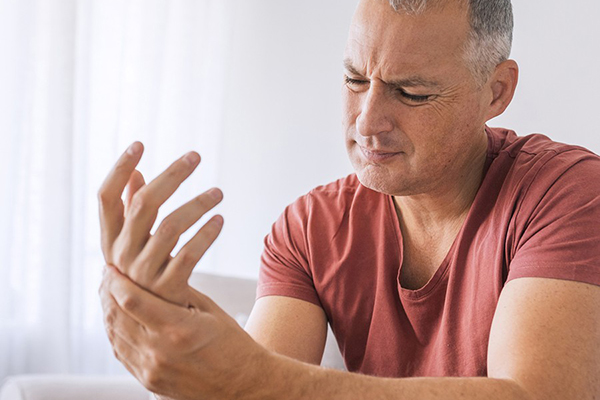Wrist, Hand & Finger
Injuries
Wrists, hands and fingers play an essential role in daily living and can often be at risk of sustaining an injury. More that 1/4 of all bones in the body are located in this area, each with numerous ligaments and tendons attached. Our wrists, hands and fingers work tirelessly each day and are particularly essential in activities such as gardening, playing an instrument, weight lifting, sports that involves throwing & catching and most forms of manual or office based work. Therefore sustaining an injury to this area can have severely detrimental impact on a person’s ability to lead a productive life.


Common treatable conditions include:
– Trigger Finger
– Wrist Sprain
– Carpal Tunnel Syndrome
– Wrist Dislocation
Trigger finger (stenosing tenosynovitis) is a painful condition which affects the tendons which flex (bend) your finger. This impacts on a person’s ability to bend and straighten their fingers. It causes pain, stiffness and a sensation of locking or catching when bending fingers. Trigger finger is associated with several other conditions such as rheumatoid arthritis, gout and diabetes, it can also occur from repetitive strong gripping actions. Symptoms of trigger finger include:
- Catching or locking sensation
- Limited range of movement
- Painful, stiff fingers or thumb
- Soreness or a bump at the base of your finger or thumb
Therapists will treat this condition with gentle mobility exercises for the finger. In the event of surgery, hand therapy can be used to help restore full use of your finger/s or thumb.
Wrist sprains occur when the ligaments which hold the bones together inside the wrist become stretched beyond their natural range. In the wrist area there are 15 bones connected together by this strong fibrous tissue, however when they twisted and overstretched this causes tears to the ligaments. There are 3 different grades of sprain (1) being minor with microscopic damage (2) moderate damage with several ligament being partially torn and (3) severe damage which can involve 1 or more ligaments being fully torn.
- Bruising and/or swelling
- Reduced range of movement
- Pain at rest which is more severe when moving the hand or wrist
- Feeling of instability
To treat a wrist sprain in the initial stages involves preventing further damage and reducing painful symptoms. Rest, ice, compression and elevation is typically employed at this stage. Electrotherapy can also be used for managing pain at this stage and throughout rehabilitation. As the swelling and pain subsides a therapist will encourage gentle mobilisation of the wrist to prevent loss long term loss of movement in the wrist. An critical part of treatment for this type of injury is rehabilitation exercises to strengthen the surrounding muscles in the wrist as well as the damaged ligament. We use a combination of isometric, eccentric and concentric exercises to ensure the wrist restores as such strength as possible. This is vital to ensure that wrist sprains do not keep occurring to weakened ligaments.
Carpal Tunnel Syndrome is a condition which is caused by compression of the median nerve as it passes through the wrist. The median nerve runs from the forearm through to the hand and fingers, controlling movements and sensations in all but the little finger. Compression of this nerve in the ‘Carpal Tunnel’ of the wrist causes numbness, weakness, burning and tingling. Common causes of this condition include: pregnancy, diabetes, obesity, rheumatoid arthritis and repetitive wrist and hand movements (for eg typing). Furthermore women are 3 times more likely to get this condition than men, possibly due to having a smaller space (Tunnel) for the nerve to run through in the wrist. Symptoms of Carpal Tunnel Syndrome include:
- Loss of strength and coordination in fingers and thumb
- Numbness and tingling in thumb and all fingers except the little finger.
- Weak grip and pinch
- Reduced feeling in fingers and thumb
Therapists would typically treat this condition by suggesting lifestyle changes if that is contributing to the condition and look at alternatives to the tasks that cause the issue. Wrist splinting can be used particularly at bedtime to reduce the numbness and tingling as you sleep. Whereas techniques such as nerve gliding can be used to mobilise the nerve. In addition introducing exercises which strengthen and stretch the wrist is often recommended. In the event of this not improving the condition, surgery which has the objective of creating more space in the Carpal tunnel to reduce tension in the area is performed.
The wrist is formed by eight small bones called carpals connected together by a network of ligaments. Damage to these ligaments such as in a tear will cause these bones to separate which can lead to a deformed appearance of the wrist. This type of injury is caused by breaking a fall with an out stretched hand, car accidents or during sports such as boxing, rugby or ice hockey. The symptoms of a wrist sprain include:
- Pain in the wrist
- Swelling or bruising or the wrist
- Discolouration of the wrist
- The wrist or fingers may have a deformed appearance.
The treatment protocol for the early onset of injury involves managing pain and preventing further damage to the ligaments. Typically this is achieved through rest, ice, compression and elevation. The wrist can also be strapped, taped or braced to limit movement whilst it heals. Exercises that strengthen and mobilise the wrist are used when the pain subsides to ensure joint integrity is restored. In more severe cases surgery is required to re-align the carpals, and rehabilitation can be performed as part of the recovery.
The metacarpals are the long bones of the hand which sit between the carpals in the wrist and the phalanges (fingers). A fracture of these bones can occur in a number of different ways such as falling onto an outstretched hand, hitting an object with a clenched fist, direct impact to the hand or a crushing injury.
Symptoms of a fractured metacarpal can include:
- Pain and swelling in the hand
- Bruising of the hand
- Difficulty moving fingers
- Potential for rotation deformity
In the initial stages following injury the hand should be splinted to prevent further damage taking place, however an x-ray and surgery may be required in more severe cases. Early and light movements are beneficial and can be performed depending on the severity of the injury. As the condition of your injury improves range of movement exercises are encouraged to work the fingers in various ranges. Strengthening and gripping exercises can then begin to be incorporated gradually to improve the condition of the surrounding tissues such as tendons, ligaments and muscles.
DeQuervain’s Tenosynovitis is an inflammatory condition of the sheath that surrounds the tendons of the thumb. The thumb tendons run from the wrist area and attach to the thumb, passing under a fibrous tunnel (sheath). Any swelling to these tendons or thickening of the sheath results in increased friction and inflammation. This condition is common in middle-aged women, and often occur from overuse. It is also associated with rheumatoid arthritis and pregnancy. The symptoms of DeQuervain’s Tenosynovitis can include:
- Difficulty moving the thumb due to pain and swelling
- A catching or snapping sensation can be felt whilst moving the thumb
- Pain felt over the thumb side of the wrist
- Swelling over the thumb side of the wrist
To treat this condition may require surgery if conservative treatments are unsuccessful, the goal of which is to increase space in the wrist/thumb compartment and reduce friction. The avoidance of activities and movements which aggravate the condition is recommended, and a splint can be used to immobilise and rest the wrist and thumb. Conservative treatments such as ice and heat can also be used to help with pain and inflammation. As the condition improves exercises to restore range of movement and strength will be introduced by a therapist. Massage and taping can also be used with this condition, to improve circulation, pain and mobility.








